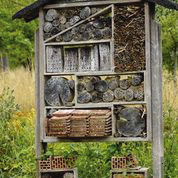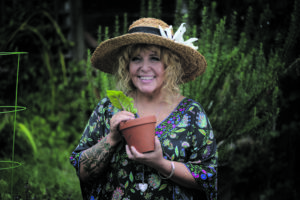The European Honeybee (Apis mellifera) gets a lot of great PR.
They do a good job of pollinating plants and in providing the standard honey that most of us are familiar with but there are thousands of other pollinators that are vital to not only our home gardens but all plants.
So, as the pollen settles on Australian Pollinator Week, I hope all the hard-working champions of the pollinating world have had their time to shine.
Let’s meet them and explore how you can help improve their chances of survival while they help you and your garden.
What is a Pollinator?
Any living thing that helps distribute the pollen of one plant to another so that it becomes fertile and can therefore reproduce is a ‘pollinator’.
This is not at all limited to bees and butterflies as there are many other insects that assist in this cycle as well as birds and mammals.
Two types of pollinators exist, those like European Honeybee that are busy collecting pollen for their own use who then, through this process, distribute pollen on their rounds and then there are pollinators who inadvertently pick up pollen while moving about a plant.
None of these set out to actively pollinate plants, it is one of those synchronistic wonders of nature.
I’m guessing that you probably do not want a whole gang of flying foxes or even certain birds to descend in great numbers in your veggie patch but these are most certainly examples of other pollinators and although they are helpful, they represent a very small part of the pollination equation.
This article focuses on insect pollinators which are, sadly, in decline.
Do All Plants Need Pollinators?
While approximately 75 per cent of the natural plant world require a pollinator, many do not.
Wind pollinated plants exist as well such as grasses, cereals and trees that rely on movement of the air to release and distribute their pollen.
Wind pollinating plant examples include corn, wheat, rice, pine trees and walnut trees.
Wind pollination means that as a plant, you don’t need flashy flowers to attract pollinators.
Your flowers can be small, and time need not be wasted producing nectar either, but what you can do is produce a lot of pollen.
This is also why many of these types of plants cause allergic reactions in people.
What does this mean for you, the gardener?
Well, if you are growing plants that require wind movement to become fertile and you are growing them indoors, in a green house or in a super sheltered spot, you might have to help them out.
This can be done by hand with a small brush by picking up the pollen from the stamen of one plant and then depositing it on the pistol of another.
A few plants are pollinated by either pollinators or the wind and these include papaya and coconut.
Another form of pollination occurs through water and while rare in the pollination chain, as most aquatic plants are actually insect-pollinated, ‘hydrophily’ is when pollen is released by a flower to float upon the surface of a waterbody to other flowers.
Seagrasses are a good example of water pollinating plants.
Is it a Bee, a Wasp or a Fly?
Often our poor native bees are mistaken for flies or wasps.
(Put down the fly spray! Put it down anyway!)
Here are a few simple ways to tell them apart (and please note that this is not always definitive for all species).
Bees have narrow, long eyes; long antennae; a broader pair of hind legs; a narrow ‘waist’; furry body and four wings which are shorter than their body.
Wasps have narrow eyes with a distinctive notch; long antennae; long, thin hind legs; a very thin ‘waist; their body is smooth with bristles and their four wings are shorter than their body.
Flies have round, large eyes; short antennae; long, thin hind legs; ‘waist’ is not noticeable; a smooth body with bristles and they have only two wings which are longer than their body.
Your Local Pollinators
There are around 2,000 identified Australian Native Bees and while some do store honey in their nests, many do not.
They are mostly solitary bees, meaning that they do not have queens and workers.
These bees also do not produce as much honey as the European Honeybee, but they are vitally important to the Australian landscape and it may come as a surprise to many, they are actually sometimes far more efficient pollinators in our home gardens and even farms.
Another important fact is that European Honeybees can, in some areas, outrun the local Native Bees with their super efficiency and need for far more pollen to keep their huge hive populations alive.
Native Bees you might see around the Coast are the gorgeously vivid blue striped Blue Banded Bee (Amegilla cingulate), often mistaken for flies, the Stingless Honeybee (Tetragonula carbonaria) and the aptly named Teddy Bear Bee (Amegilla bombiformis).
Other insect pollinators include wasps, flies, beetles, thrips, mosquitos, moths and of course butterflies, an example of which is the common to The Coast is the Monarch Butterfly (Danaus plexippus).
Encouraging Insect Pollinators to Your Garden
Just like us, different insects have various preferences.
Some are also nectar feeders while others are pollen feeders.
To entice and feed the locals, here are a few plants that Native Bees love that you could plant in your gardern: Angophora (Angophora), Butterfly Bush (Buddleja), Myrtle (Baeckea) Bottlebrush (Callistemon), Gum (Eucalyptus), Grevillea (Grevillea), Lavender (Lavandula) Tea-Tree (Leptospermum) and Native Rosemary (Westringia), Daisy (Bracteantha, Brachyscome, Osteospermum and Erigeron)
Strong scented flowers will tend to attract flies and beetles so plans like marigolds, daisies and magnolias are favoured. Roses and orchids are great attractors of butterflies and months as they prefer sweet smelling flowers.
Create a Pollinator Home
While many of the pollinators will be happy to stumble in and out of your garden, you can help them create their home by providing areas for them to nest in and this is particularly helpful for native insects, especially bees.

The easiest way to do this is simply by collecting a bunch of hollowed stems, tying them together and then hanging in a shaded, quiet area of your garden.
You can also create nesting boxes from drilled hardwood (create varying dimension in your holes) or purchase pre-made insect hotels.
If you are interested in having a native bee hive, then the good people at Aussie Native Bees can help www.aussiebee.com.au and their website has lots of great information and resources.
Year-Round Pollinator Recording
Each year in November, Australia holds Pollinator Week to highlight all pollinators and to help the public identify and so hopefully protect these vital beings of our precious ecosystems.
You do not have to end your exploration and understanding of these industrious beings after November.
Hop on to www.wildpollinatorcount.com to find resources that will help you identify particularly insects that are important to your local ecology and garden and to see how you can help with your observations all year long.
Helpful Technology
There are lots of websites and apps out there to help with insect identification and I recommend the following to help in your pollinator exploration and discovery.
‘What Bug Is That’ website by the CSIRO will help you track down the various insect families in Australia and put you on the right path to proper identification: http://anic.ento.csiro.au/insectfamilies/
‘Insect Identification for the Casual Observer’ is a brilliant website that helps you work out what your bug may be through its various characteristics: https://www.insectidentification.org/bugfinder-start.asp
‘Picture Insect’ is an app available for your phone that help identify your insect via a photo you take, search ‘Picture Insect’ in your app store.
In the Vegetable Garden
You can attract pollinators in your vegetable garden by adding these in amongst your beds (some are also handy herbs!): sunflower, marigolds, alyssum, cosmos, calendula, Queen Anne’s Lace daisies, salvias, penstemons, lavender, oregano, borage, basil, yarrow, dill, parsley, rosemary.
Looking after our pollinators in the garden means using organic and non-harmful to pollinator control methods. Planting things they need and enjoy and also having a water source for them. You could leave flat trays of water out on especially hot days.
A tiny list of examples of garden produce plants that require pollinators: Fruiting trees, berries, melons, squashes, tomatoes, chillies, eggplants, celery, beetroot, broccoli, cauliflower, cabbage, coriander, cucumber, carrot, fennel, strawberry, alfalfa, passionfruit, beans and so the list goes on.
So, if you want a bountiful veggie patch, look after your pollinators!
UPCOMING GARDEN EVENTS
AUSTRALIAN POLLINATOR WEEK –
8th – 15th November to help with a focused count and local and only educational activities: www.australianpollinatorweek.org.au and year round on www.wildpollinatorcount.com
TOOL DRIVE: SWAMP –
(Sustainable Wetlands Agricultural Makers Project) Central Coast. New Community Garden at Tuggerah is looking for donations of your unloved gardening and handy tools. Meet the team and drop off in the overflow carpark opposite Tuggerah Super Centre Friday 20th Nov 2pm – 6pm & Saturday 21st. 6am to 12pm www.swampcentralcoast.com.au
THIS WEEK YOU CAN PLANT
Asian greens, beetroot, broccoli, beans, capsicum, chilli, eggplant, pumpkin, turnips, sweet corn, squash, zucchini, coriander, rocket, rosemary, thyme, mint, parsley amaranths, aster, begonia, Californian poppy, cosmos, sunflower, snapdragons, zinnia.

Cheralyn Darcey is a gardening author, community garden coordinator and along with Pete Little, hosts ‘The Gardening Gang’ 8 – 9am every Saturday on Coast FM.
Send your gardening events and news to: gardeningcentralcoast@gmail.com


